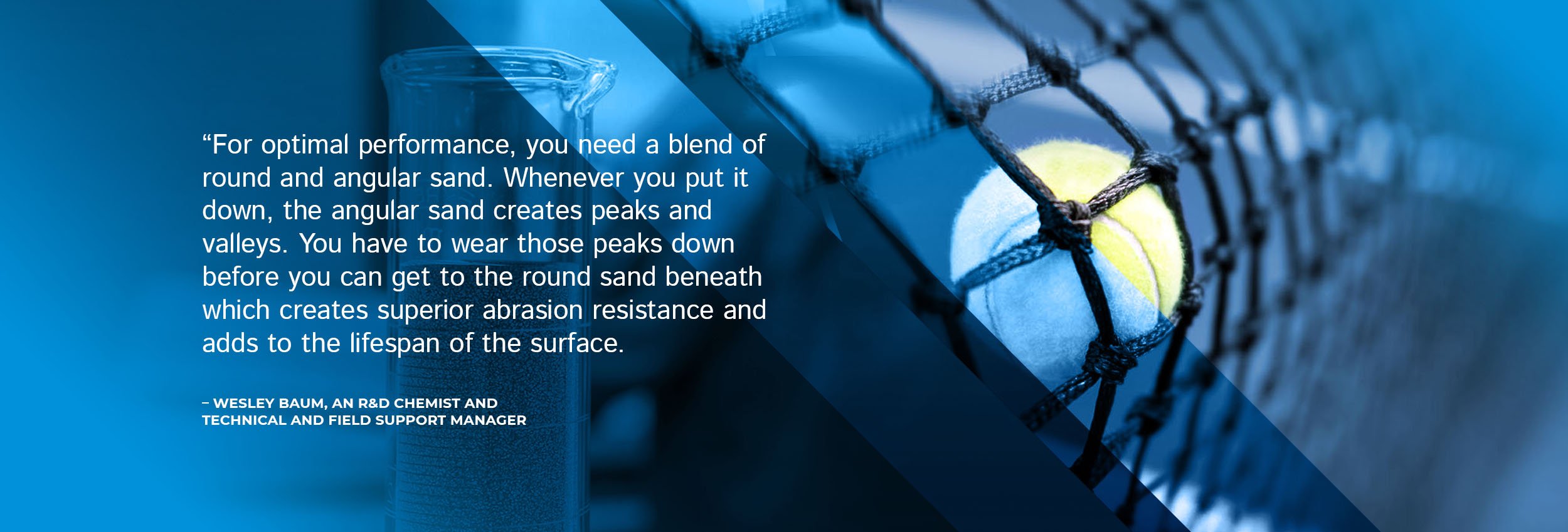What role does sand play in court performance and durability?
MAKING WORLD CLASS TENNIS COURTS REQUIRES A GRANULAR ATTENTION TO DETAIL
As granular as a grain of sand in fact. Here we explore why sand is so important to a court’s performance and durability and how to get it right.
SAND IS AN AGENT OF PACE AND LONGEVITY
Sand plays two important roles in a tennis court’s performance.
It controls the pace of the surface. Your sand rating is essentially your pace rating. Ensuring the right type and blend of sand will ensure consistency of surface pace and therefore, speed of play.
It provides increased abrasion resistance which, in its simplest and most important terms, prolongs the lifespan of the court.
So as invisible as it can (and should) be, sand is an extremely valuable ingredient in court manufacture and forms the basis of a surface’s performance and durability. But of course, it is not quite as simple as that.
THE SCIENCE IS IN THE BLEND
Ensuring optimal performance and longevity, requires you to get even more granular. It is not just the presence of sand that is important but the type and blend of sand that is used. It comes down to the specific angles of the grains and how they interact with the grains around them.
Wesley Baum, an R&D chemist and Technical and Field Support Manager for Laykold, explains;
“For optimal performance, you need a blend of round and angular sand. Whenever you put it down, the angular sand creates peaks and valleys. You have to wear those peaks down before you can get to the round sand beneath which creates superior abrasion resistance and adds to the lifespan of the surface.”
THE LONGEST WARRANTIES ON THE MARKET
Through R&D investment, Laykold has developed a proprietary blend of sand for its Masters System. The exact blend remains an industry secret but this, combined with a unique acrylic with a higher solids content which serves to lock the sand in more securely, provides consistent surface pace and enables us to provide five year warranties - the longest on the market.
WHAT HAPPENS WHEN SAND SURFACES?
The irony of this investment, is that a good court is invisible. It is only when issues rise to the surface and players start to complain, that the court enters the spotlight. A recent high-profile example of this was in the ATP Cup lead-up event to the Australian Open at the Queensland Tennis Centre in January when John Millman raised concerns about sand on the court. This is a challenge for all courts, especially at the top level. But why did it happen and what impact does it have?
Probable reasons include:
The use of sub-optimal, round sand that can come loose and roll out of the surface more easily.
Soft acrylics with a lower solids content that do not contain the sand as effectively.
The impact of sand surfacing on the courts in this way is threefold:
Sand rising means that the court speeds up and consistency of play is compromised.
As was visible in John Millman’s case, the possibility of players slipping and risking injury on the loose grains is increased so player welfare is at stake. So, arguably, is the fan experience.
The surface friction will increase resulting in greater wear and tear and less durability which has a higher financial and environmental cost over the court’s shortened lifespan.
RECIPE FOR SUCCESS
Sand, therefore, is a crucial ingredient in all courts, and especially those at the top level. The quality of the ingredients used and how they are mixed and blended is also a key component of a successful recipe. Courts are no different.
IN THE MARKET FOR NEW COURTS? GET GRANULAR
A good court is the unsung hero of the game, and the sand makes up a considerable part of its power. So if you’re in the market for resurfacing your existing courts or laying new ones, we strongly recommend getting granular. Ask about the grains and the specific blend of sand. Get your hands sandy. Because therein lies the secret for performance and durability.
LAYKOLD - OFFICIAL COURT SURFACE OF THE US OPEN
From this year, Laykold will be the official court surface of the US Open. Part of the reason we were trusted and chosen by the United States Tennis Association (USTA) to provide the surfaces for their biggest tournament was because of the performance and durability assurances we could provide. Our proprietary blend of sand is at the foundation of this assurance and it is available worldwide as part of our Masters System from grassroots communities to Grand Slams.

